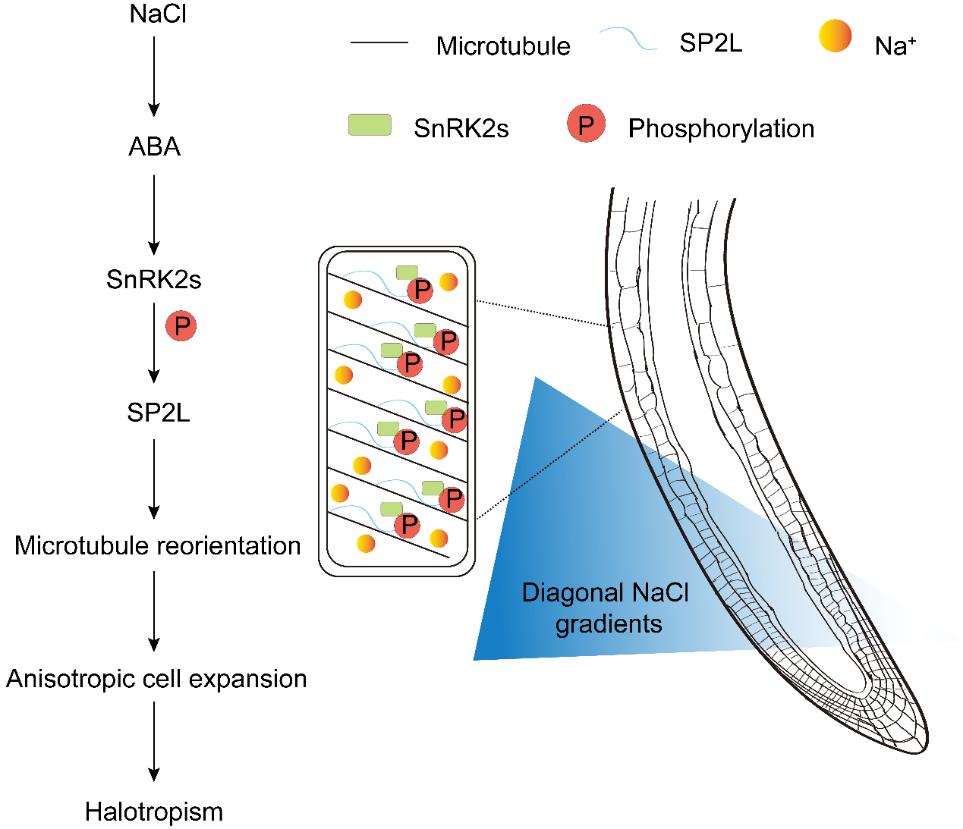How do Plants Escape from the Saline Environment? CAS Scientists have made Discoveries.
As sessile organisms, to avoid deleterious microenvironments, plants have evolved tropic and nastic movements that help them grow toward an optimal environment. Plant organs could integrate environmental signals to optimize growth, including light (phototropism), gravity (gravitropism), nutrients (nutritropism), chemicals (chemotropism), contact (thigmotropism), and water (hydrotropism). Root halotropism is a sodium-specific negative tropism that is crucial for surviving and thriving under high salinity. Although root halotropism was discovered some years ago, the underlying molecular and cellular mechanisms remain unknown.
Scientists from CAS Center for Excellence in Molecular Plant Sciences (CEMPS) now reported that ABA-activated SnRK2 protein kinases phosphorylate SP2L to regulate root halotropism. To investigate molecular mechanisms that underpin root halotropism in Arabidopsis, they optimized the vertical split-agar assay in which root tips were subjected to diagonal NaCl gradients. Further study found salt stress activates ABA-dependent protein kinase SnRK2.6, phosphorylating microtubule-binding protein SP2L at Ser406, which in turn controls cortical microtubule reorientation. Salt stress triggers SP2L-mediated microtubule rearrangement to guide cellulose microfibril patterns, which changes the anisotropic cell expansion in the root transition zone and drives root halotropism in Arabidopsis. Thus, scientists present a Cholodny-Went-theory-independent mechanism in which stimuli-induced microtubule reorientation determines tropic growth during root halotropism in Arabidopsis.
These findings outline the molecular and cellular mechanisms of root halotropism and indicate that anisotropic cell expansion through microtubule reorientation and microfibril deposition has a central role in mediating tropic responses.
This study was published on Developmental Cell on October 14, 2022. Prof. Yang Zhao from the CAS Center of Excellence in Molecular Plant Sciences (CEMPS) is the corresponding author. Dr. Bo Yu at CEMPS is the first author and performed all genetic and biochemical studies. Prof. Staffan Persson and Dr. Wenna Zheng at the University of Copenhagen did excellent work on monitoring microtubule reorientation, CesA patterns, and cell expansion in the root transition zone during root halotropism. Scientists from other institutes also contribute to this work, including Dr. Lu Xing at Purdue University and Prof. Jian-Kang Zhu at Southern University of Science and Technology. This study was supported by the National Natural Science Foundation of China, the Strategic Priority Research Program of the Chinese Academy of Sciences, the Science and Technology Commission of Shanghai Municipality, ARC Discovery grant, Villum Investigator, DNRF Chair, and Novo Nordisk Laureate, Novo Nordisk Emerging Investigator and Lundbeck foundation grants.

Schematic model for ABA- and SP2L-mediated root halotropism
Article link: https://doi.org/10.1016/j.devcel.2022.09.012
Contact: Prof. Yang Zhao, Center for Excellence in Molecular Plant Sciences (CEMPS), Chinese Academic of Sciences
Email: zhaoyang@cemps.ac.cn
